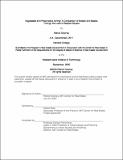| dc.contributor.advisor | Kairos Shen. | en_US |
| dc.contributor.author | Downey, Patrick(Patrick R.) | en_US |
| dc.contributor.other | Massachusetts Institute of Technology. Center for Real Estate. Program in Real Estate Development. | en_US |
| dc.date.accessioned | 2021-01-06T17:40:08Z | |
| dc.date.available | 2021-01-06T17:40:08Z | |
| dc.date.copyright | 2020 | en_US |
| dc.date.issued | 2020 | en_US |
| dc.identifier.uri | https://hdl.handle.net/1721.1/129101 | |
| dc.description | Thesis: S.M. in Real Estate Development, Massachusetts Institute of Technology, Program in Real Estate Development in conjunction with the Center for Real Estate, September, 2020 | en_US |
| dc.description | Cataloged from student-submitted PDF of thesis. | en_US |
| dc.description | Includes bibliographical references (pages 88-94). | en_US |
| dc.description.abstract | Permitting and executing large scale real estate developments in Boston, Massachusetts is difficult. The process is time and capital intensive due to the nature of an outdated zoning code that exists to induce project-by-project negotiation with the central permitting authority, the Boston Planning and Development Agency ("BPDA"). Critics of the BPDA and Boston's zoning system contend that the city's zoning practices favor developers and investors at the expense of thoughtful neighborhood building and public benefits. In light of this argument, this paper analyzes the public benefits secured by the city at Seaport Square and compares them against the estimated public benefits produced by the highly prescriptive zoning code of Seattle, Washington. The analysis begins with a general comparison of prescriptive versus negotiated zoning frameworks before more specifically comparing the respective systems in Seattle (highly prescriptive) and Boston (highly negotiated). It then provides a narrative overview of the Seaport Square zoning and permitting process to date to provide context around the public-private negotiation, itemize public benefits secured, and illustrate the mechanics of how those benefits are delivered. After evaluating the actual public benefits generated in Boston, the application of zoning regulations of an analogous neighborhood in Seattle is used to estimate public benefit outputs of Seaport Square under a legislatively prescribed zoning environment. Finally, it assesses common arguments against Boston's current zoning framework and discusses potential implications of a shift toward a more predictable, prescriptive system. | en_US |
| dc.description.statementofresponsibility | by Patrick Downey. | en_US |
| dc.format.extent | pages | en_US |
| dc.language.iso | eng | en_US |
| dc.publisher | Massachusetts Institute of Technology | en_US |
| dc.rights | MIT theses may be protected by copyright. Please reuse MIT thesis content according to the MIT Libraries Permissions Policy, which is available through the URL provided. | en_US |
| dc.rights.uri | http://dspace.mit.edu/handle/1721.1/7582 | en_US |
| dc.subject | Center for Real Estate. Program in Real Estate Development. | en_US |
| dc.title | Negotiated and prescriptive zoning : a comparison of Boston and Seattle through the lens of Seaport Square | en_US |
| dc.type | Thesis | en_US |
| dc.description.degree | S.M. in Real Estate Development | en_US |
| dc.contributor.department | Massachusetts Institute of Technology. Center for Real Estate | en_US |
| dc.identifier.oclc | 1227099066 | en_US |
| dc.description.collection | S.M.inRealEstateDevelopment Massachusetts Institute of Technology, Program in Real Estate Development in conjunction with the Center for Real Estate | en_US |
| dspace.imported | 2021-01-06T17:40:07Z | en_US |
| mit.thesis.degree | Master | en_US |
| mit.thesis.department | RED | en_US |
